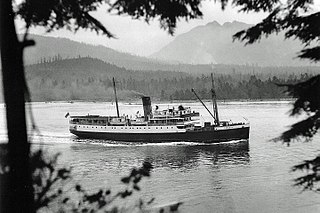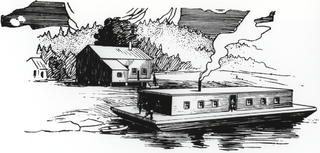
Simon Fraser University (SFU) is a public research university in British Columbia, Canada, with three campuses, all in Greater Vancouver: Burnaby, Surrey, and Vancouver. The 170-hectare (420-acre) main Burnaby campus on Burnaby Mountain, located 15 kilometres (9.3 mi) from downtown Vancouver, was established in 1965 and comprises more than 30,000 students and 160,000 alumni. The university was created in an effort to expand higher education across Canada.

Petersburg is a census-designated place (CDP) in and essentially the borough seat of Petersburg Borough, Alaska, United States. The population was 3,043 at the 2020 census, up from 2,948 in 2010.

Richmond is a city in the coastal Lower Mainland region of British Columbia, Canada. It occupies almost the entirety of Lulu Island, between the two estuarine distributaries of the Fraser River. Encompassing the adjacent Sea Island and several other smaller islands and uninhabited islets to its north and south, it neighbours Vancouver and Burnaby on the Burrard Peninsula to the north, New Westminster and Annacis Island to the east, Delta to the south, and the Strait of Georgia to the west.

Comox is a town on the southern coast of the Comox Peninsula in the Strait of Georgia on the eastern coast of Vancouver Island, British Columbia. Thousands of years ago, the warm dry summers, mild winters, fertile soil, and abundant sea life attracted First Nations, who called the area kw'umuxws.
Steveston, founded in the 1880s, is a neighbourhood of Richmond in Metro Vancouver. On the southwest tip of Lulu Island, the village is a historic port and salmon canning centre at the mouth of the South Arm of the Fraser River. The early 1900s style architecture attracts both the film and tourism industries.

Nii-jima (新島) is a volcanic Japanese island administered by the Tokyo Metropolitan Government. It is one of the Izu Seven Islands group of the seven northern islands of the Izu archipelago, and is located approximately 163 kilometres (101 mi) south of Tōkyō and 36 kilometres (22 mi) south of Shimoda Shizuoka Prefecture. The island is the larger inhabited component of the village of Niijima Village, Ōshima Subprefecture of Tokyo Metropolis, which also contains the neighboring island of Shikine-jima and the smaller, uninhabited Jinai-tō. Nii-jima is also within the boundaries of the Fuji-Hakone-Izu National Park.

Lulu Island is the name of the largest island in the estuary of the Fraser River, located south of Vancouver, British Columbia, Canada, and the second-most populous island in British Columbia, after Vancouver Island. The city of Richmond occupies most of the island, while a small section at the eastern tip, known as Queensborough, is part of the city of New Westminster.

Shikine-jima (式根島) is a volcanic Japanese island in the Philippine Sea. The island is administered by Tōkyō and located approximately 160 kilometres (99 mi) south of Tōkyō and 36 kilometres (22 mi) south of Shimoda Shizuoka Prefecture. It is one of the Izu Seven Islands group of the seven northern islands of the Izu archipelago. The island is the smaller inhabited component of the village of Niijima, which also contains the larger, neighboring island of Niijima and the smaller, uninhabited Jinai-tō. It is part of the Ōshima Subprefecture of Tokyo Metropolis. As of 2009, the island's population was 600. Shikinejima is also within the boundaries of the Fuji-Hakone-Izu National Park.

Coal Harbour is a harbour and community on northern Vancouver Island, British Columbia, Canada located on the north side of Holberg Inlet in the Quatsino Sound region. It is named after a small and unsuccessful local coal mine that was founded in 1883. The village's most successful industry, however, was whaling. It was the last whaling station in British Columbia when it closed in 1967. The station utilized the original buildings of the RCAF.

The Gulf of Georgia Cannery is a National Historic Site of Canada located in Steveston village in Richmond, British Columbia.
Boswell was a cannery town in the Central Coast region of the South Coast of British Columbia, Canada, located on the north side of Boswell Inlet, an arm of Smith Sound.

For more than 35 years, from 1923 to 1958, the Union steamship Cardena sailed the British Columbia Coast, carrying passengers, groceries, dry goods, industrial cargo, mail and sundry other supplies to the 200 or so mining, logging and fishing communities that once dotted the province's coastline during the early years of the 20th century. On her return voyage, at the peak of the summer fishing season, Cardena routinely carried thousands of cases of canned salmon to the railheads at Prince Rupert and Vancouver for shipment across Canada and around the world. And so it went for the better part of half a century; a regular and reliable marine service that made Cardena a coastal institution, remembered with affection and regard by the countless men, women and children who inhabited those tiny outports in a bygone era.

A salmon cannery is a factory that commercially cans salmon. It is a fish-processing industry that became established on the Pacific coast of North America during the 19th century, and subsequently expanded to other parts of the world that had easy access to salmon.
The Workers' Compensation Board of British Columbia, operating as WorkSafeBC, is a statutory agency that came into existence in 1917, after the provincial legislature put into force legislation passed in 1902. This legislation is known as the Workers Compensation Act.

The Shrum Bowl was a university rivalry game played between the gridiron football teams of the University of British Columbia (UBC) Thunderbirds and the Simon Fraser University (SFU) Red Leafs. The game was named after Gordon Shrum who was a professor and later a dean at UBC from 1925 to 1961 and served as the first chancellor of SFU from 1964 to 1968. It was a cross-town rivalry with UBC being located in the University Endowment Lands just west of Vancouver, British Columbia, and SFU located approximately 30 kilometres away in Burnaby, British Columbia.

Clover Leaf Seafoods Company is the leading marketer brand of canned seafood in the Canadian market owned by British equity firm Lion Capital LLP. Headquartered in Markham, Ontario, it sells canned, shelf-stable, and frozen goods under the Clover Leaf and Brunswick brands. The company's products include tuna, salmon, oysters, mussels, clams, shrimp, crab, lobster and sardines. Clover Leaf Seafoods was formerly owned by Canadian Connors Brothers Limited when merged with American counterpart brand Bumble Bee Seafoods in 2003, it was then sold to American equity firm Centre Partners in 2005, then sold to Lion Capital in 2010, still paired with Bumble Bee.
Kildonan is an unincorporated community in the Alberni Inlet-Barkley Sound region of the west coast of southern Vancouver Island, British Columbia. The former steamboat landing and ferry dock is on the east shore of Uchuchklesit Inlet, which branches northwest of the lower reaches of Alberni Inlet. Adjacent to Pacific Rim National Park Reserve, the locality is by road and ferry about 120 kilometres (75 mi) southwest of Port Alberni.

The SFU Red Leafs football or Simon Fraser Red Leafs football team represented Simon Fraser University since the athletic department's inception in 1965 until 2022. The team played by American rules while they competed in the National Association of Intercollegiate Athletics from 1965 to 2001 against other American teams. Along with other SFU teams, the football program transferred to Canadian Interuniversity Sport and thereby switched to playing Canadian football against Canadian University teams in 2002. While playing in the CIS, SFU won its first and only Hardy Trophy conference championship in 2003 while qualifying for the playoffs twice. After playing eight seasons in the Canada West Conference of the CIS, the football team began competing in the Great Northwest Athletic Conference of NCAA Division II in 2010, and have played the American format of football again since. After the GNAC dropped football after the 2021 season, SFU and the other two GNAC members that still sponsored the sport became football-only members of the Lone Star Conference. After the 2022 season, it was announced on April 4, 2023, that football would be dropped from the school after it was previously announced the Lone Star Conference was ending its affiliation with Simon Fraser after the 2023-24 season.
The history of Chinese Canadians in British Columbia began with the first recorded visit by Chinese people to North America in 1788. Some 30–40 men were employed as shipwrights at Nootka Sound in what is now British Columbia, to build the first European-type vessel in the Pacific Northwest, named the North West America. Large-scale immigration of Chinese began seventy years later with the advent of the Fraser Canyon Gold Rush of 1858. During the gold rush, settlements of Chinese grew in Victoria and New Westminster and the "capital of the Cariboo" Barkerville and numerous other towns, as well as throughout the colony's interior, where many communities were dominantly Chinese. In the 1880s, Chinese labour was contracted to build the Canadian Pacific Railway. Following this, many Chinese began to move eastward, establishing Chinatowns in several of the larger Canadian cities.

The history of Japanese people in British Columbia began with the arrival of Manzo Nagano in New Westminster in 1877. Prior to 1942, British Columbia was home to 90% of all Japanese in Canada. In 2001, 44% of all Japanese Canadians lived in British Columbia, or about 1% of the province's total population.















